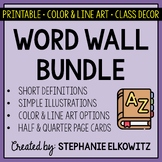Ecology and Ecosystems Word Wall | Science Vocabulary
- Zip
What educators are saying
Also included in
- Save 40% by purchasing ALL my Earth, Life, Physical and Nature of Science word wall sets!Build science vocabulary and encourage science literacy in your classroom with a science word wall! Download this bundle of science word wall cards to help create an eye-catching display in your classroom.ImportPrice $82.80Original Price $138.00Save $55.20
- Save 35% by purchasing ALL my LifeScience word wall sets!Build science vocabulary and encourage science literacy in your classroom with a science word wall! Download this bundle of science word wall cards to help create an eye-catching display in your classroom.Important Notes:• Download a FREE unitPrice $33.15Original Price $51.00Save $17.85
- Save 40% by purchasing ALL my NGSS aligned Ecology teaching materials!Important Notes:• Download a FREE Unit Bundle to learn more about all my products.• Save $$$ with the Life Science Complete Curriculum• Save $$$$ with the Integrated Science Complete Curriculum• Consider Daily Lessons as an economPrice $127.20Original Price $212.00Save $84.80
Description
Build science vocabulary and encourage science literacy in your classroom with a science word wall! Download this set of science word wall cards to help create an eye-catching display in your classroom.
Important Notes:
• Download a FREE unit of Word Wall Cards
• Save $$$ with the Life Science Complete Curriculum
• Save $$$$ with the Integrated Science Complete Curriculum
About my Word Wall Cards
• Each card includes a simple illustration, one vocabulary word and a short definition
• There are four different versions of word wall cards included with this download:
- Half Page Full Color
- Half Page Line Art (B&W)
- Quarter Page Full Color
- Quarter Page Line Art (B&W)
• This resource is not editable.
• This resource is print only.
EZ Printing and Assembling
Cards are designed to be printed on letter-sized paper with an even white border. Cuts along the light grey dotted line(s) will produce cards with an even white border. No additional cutting is needed to achieve a uniform border.
*********************************************************************************************************
Terms Included:
Ecology
Ecologist
Environment
Habitat
Autotroph
Heterotroph
Decomposer
Herbivore
Omnivore
Carnivore
Scavenger
Food Chain
Food Web
Detritivore
Pollinator
Seed Disperser
Water Cycle
Evaporation
Transpiration
Condensation
Precipitation
Infiltration
Runoff
Photosynthesis
Cellular Respiration
Biotic Factor
Abiotic Factor
Individual
Species
Population
Community
Ecosystem
Biome
Biosphere
Energy Pyramid
Trophic Level
Niche
Competition
Predation
Symbiosis
Commensalism
Mutualism
Parasitism
Carbon Cycle
Decomposition
Fossil Fuels
Carrying Capacity
Limiting Factor
Polar Region
Tundra
Permafrost
Taiga
Temperate Forest
Temperate Grasslands
Savanna
Desert
Tropical Rainforest
Freshwater Ecosystem
Marine Ecosystem
Ecological Succession
Biodiversity
Ecosystem Diversity
Genetic Diversity
Species Diversity
Primary Succession
Secondary Succession
Pioneer Species
Climax Community
*********************************************************************************************************
How are word wall cards used?
They are most often used in a classroom on a bulletin board to create a visual display. A visual word wall helps students recall and remember essential science vocabulary because it provides a reference for students to review and reinforce terms on a daily basis.
Suggested Use
• Use half-page cards to create bulletin board displays
• Allow students to color and decorate B&W cards to personalize the classroom word wall.
• Use quarter-page cards to create mini displays at science centers
• Use quarter-page cards to create student dictionaries.
• I like using 10-inch coupon holders if creating student dictionaries with quarter-page cards.
NGSS Alignment
• This resource supports NGSS 3-LS4-4, 5-PS3-1, 5-LS2-1, MS-LS2-1, MS-LS2-2, MS-LS2-3, MS-LS2-4 and MS-LS2-5.
NEXT GENERATION SCIENCE STANDARDS
The terms selected for this unit are chosen to support Next Generation Science Standards and Disciplinary Core Ideas for grades 3-5 and 6-8. I differentiate each term in this resource pack as being a basic, intermediate or advanced vocabulary word. I use the Next Generation Science Standards and Disciplinary Core Ideas to help categorize the terms. This differentiation code spans across all my product lines.
TERMS OF USE
• All rights reserved by Stephanie Elkowitz.
• This product is to be used by the original purchaser only.
• Intended for classroom and personal use only.
• Copying for more than one teacher, classroom, department, school, or school system is prohibited.
• This product may not be distributed or displayed digitally for public view.
• Failure to comply is a copyright infringement and a violation of the Digital Millennium Copyright Act (DMCA).





